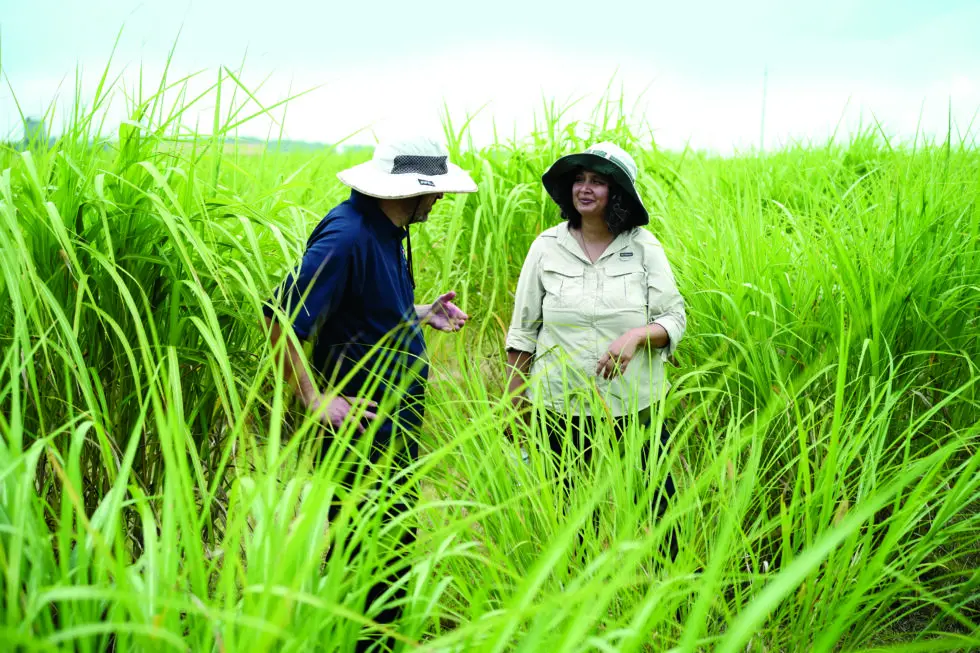
For the first time, researchers have successfully demonstrated precision gene editing in miscanthus, a promising perennial crop for sustainable bioenergy production.
A team at the Center for Advanced Bioenergy and Bioproducts Innovation (CABBI), a Bioenergy Research Center (BRC) funded by the U. S. Department of Energy, edited the genomes of three miscanthus species using CRISPR/Cas9 — a far more targeted and efficient way to develop new varieties than prior methods.

The results will accelerate efforts to tap the huge potential of this highly productive but genetically complex grass as a source for biofuels, renewable bioproducts, and carbon sequestration. The study, published in Biotechnology for Biofuels and Bioproducts, was led by three CABBI miscanthus researchers at the HudsonAlpha Institute for Biotechnology in Alabama — Faculty Investigator Kankshita Swaminathan, Research Associate Anthony Trieu and former Postdoctoral Researcher Mohammad Belaffif — and Nancy Reichert, Professor of Biological Sciences at Mississippi State University.
Swaminathan co-led an international team that sequenced the miscanthus genome in 2020. That work provided a road map for researchers exploring new ways to maximize the plant’s productivity and decipher the genetic basis for its desirable traits. Miscanthus is extremely adaptable and easy to grow. It can thrive on marginal lands, requires limited fertilization, has a high tolerance for drought and cool temperatures, and uses the more efficient C4 form of photosynthesis.
To date, efforts to genetically improve miscanthus have focused on transforming plants by introducing external genes at random places in their genomes, rather than targeting specific sites or modifying existing genes.
The CABBI team developed gene-editing procedures using CRISPR/Cas9 that will allow researchers to selectively target existing genes within miscanthus plants to knock out, or modify, their function and introduce new genes into precise locations. That targeting ability presents a new avenue for genetic improvement of this important biomass crop.
The study demonstrated gene-editing in three species of miscanthus — the highly productive Miscanthus x giganteus, which is grown commercially for bioenergy, and its parents, M. sacchariflorus and M. sinensis. Because those plants are paleo-polyploids — with duplicated ancient sorghum-like DNA and multiple sets of chromosomes — the design of the guide RNAs that locate genetic material for editing needed to target all copies of a gene, to account for redundancy and ensure a full “knock out.”
The CABBI researchers built on similar gene editing in Zea mays (maize), which identified the lemon white 1 (lw1) gene as a helpful target for visual confirmation of genetic changes. That gene is involved in chlorophyll and carotenoid biosynthesis, which affects leaf color, and prior studies demonstrated that editing lw1 via CRISPR/Cas9 yielded pale green/yellow, striped, or white leaf phenotypes.
Using sequence information from both miscanthus and sorghum, researchers identified guide RNAs that could target homeologs, or duplicated gene copies, of lw1 in miscanthus plant tissue. The leaves on the edited miscanthus plants displayed the same phenotypes found in maize, with pale green/yellow, striped, or white leaves instead of the typical green.
The work enhances CABBI’s mission to develop sustainable production of bioenergy and to engineer select feedstocks (miscanthus, sorghum, and sugarcane) to produce novel bioproducts, such as oils and specialty chemicals. Prior to this study, the bioengineering work was limited to sorghum and cane because the methods for precise engineering in miscanthus had not been developed.
“Identifying transformable germplasm, developing reliable transformation methods, and demonstrating gene editing in miscanthus are all crucial steps toward pathway engineering in miscanthus,” Swaminathan said. “The ability to precisely edit miscanthus to enhance productivity, enable continued growth on marginal lands, and produce specialty chemicals such as oils will help remove the ‘potential’ from its status as a viable bioenergy crop.
“This research helps us move a few steps closer to reducing our reliance on petroleum-based energy.”

To identify miscanthus lines that transformed well, the researchers screened germplasm from commercial vendors and the study’s collaborators. Most of the lines were supplied by co-author Erik Sacks, Professor of Crop Sciences at the University of Illinois Urbana-Champaign, who has collected germplasm from around the globe. Sacks and Swaminathan are Deputy Theme Leaders for CABBI’s Feedstock Production research.
“This research project was a highly collaborative, multi-institutional effort with researchers working across disciplines to achieve an important goal. It reinforced the ‘big picture’ approach to research within CABBI, as well as in other BRCs,” Reichert said.
Other CABBI co-authors on the study included Steve Moose, Professor of Crop Sciences at Illinois; Tom Clemente, Eugene W. Price Distinguished Professor of Biotechnology at the University of Nebraska Center for Plant Science Innovation; Postdoctoral Researcher Pradeepa Hirannaiah, Technician Shilpa Manjunatha, Intern Rebekah Wood, and Workforce Development Specialist Yokshitha Bathula, all of HudsonAlpha; and Research Associate Rebecca Billingsley and Graduate Student Anjali Arpan of Mississippi State.
— News release by Julie Wurth, CABBI Communications Specialist